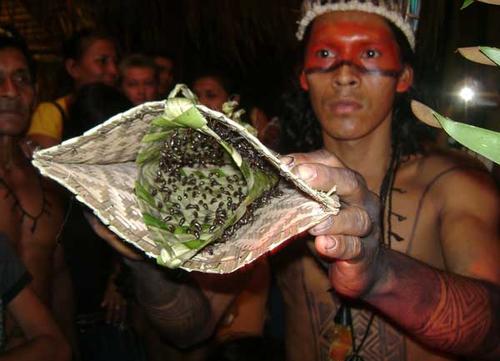Comparative Analysis of Rites of Passages Found in Dune and Real World Practices
Introduction
Going through a rite of passage has been a technique long used throughout history to show an individual's worthiness to enter the next phase or aspect in life. It can be found as far back as 40,000 years ago involving native Australian Aborigines inducting young adolescents into "man-hood".1 In some cultures the rite of passage is looked at as part of the maturing process for the individual going through it and is sometimes even used to measure their worth. We will take a more in-depth look at the rite of passage that Paul Muad'Dib must under-go to prove that he is a human and possibly the Kwisatz Haderach in Frank Herbert's novel Dune , and then compare and contrast this with other real world instances practiced by tribes and a unique computer scientist.
There are a plethora of different examples of tribes and societies using initiations or rite of passages to test a person's abilities and dedication to get through it. Specifically we will look at three cases that each uniquely relate to the passage that Paul Muad'Dib had to face. The first ritual involves the Algonquin Indians native to Quebec. Elders of the tribe take 15 to 16 yea old boys and lock them in make shift cages out in the middle of the forest. The young boys are fed a drug called "Wysoccan" which is a powerful hallucinogen and spend 20 days out in the woods secluded from their tribe where they are intended to transform into men.8 The second case, which is most comparable to Paul's experience, involves the Sateré-Mawé tribe that lives in the Amazon. In order for men to become "warriors" in the tribe they must succumb to hundreds of bullet ant stings while they don gloves filled with the insects. The hopeful warriors must wear the gloves and endure the excruciating pain for at least 10 minutes.6 The last example comes in the form of a test invented by Alan Turing, a famous British computer pioneer, called the Turing Test. This test was used to test a machine's ability to exhibit behavior that mimicked that of a human. In layman terms it can be thought of as a test to determine if something is human or not. Paul had a very similar test administered to him by the Reverend Mother to determine whether he was an animal or human.
Paul's Rites of Passage
Paul's initial rite of passage came in the first chapter of the book and was administered by the Reverend Mother. It involved him inserting his hand into a mysterious box that induced a severe burning sensation without actually causing him any harm. If he instinctively pulled his arm out when the pain started then he would have been injected with the deadly Gom Jabbar. This test was given to him in order to determine whether he was a human (and possible Kwisatz Haderach) or an animal, by testing Paul’s natural instincts. Luckily, Paul passed the test and was able to keep his hand within the box even after describing the pain as "He thought he could feel skin curling black on the agonized hand, the flesh crisping and dropping away until only charred bones remained."3 This truly demonstrates Paul's ability to subdue his animalistic instincts and think more logically like a human. This rite of passage will be evaluated further as it is compared with the Sateré-Mawé tribe rituals.
After Paul and Jessica joined the Fremen tribe, Paul had a monumental rite of passage that he had to complete. It involved him intentionally attracting a Maker and then riding it throughout the Arrakis desert. Other male Fremen completed this task at an age much younger the Paul's, so in order for him to be fully inducted into the tribe he would have to mount the Maker. Fortunately he was able to complete the ritual, even after attracting one of the largest worms ever seen.
Additionally, Paul underwent one last rite of passage that he administered on himself. This occurred in part three of the book when he consumed the "raw water" or excretion of a drowned worm. It rendered him almost lifeless, in a trance like state for three weeks until Chani was able to figure what happened and revived him. It was the last test that Paul had to pass in order to truly become the Kwisatz Haderach and see more than any Reverend Mother could ever see. The rituals that Paul underwent were very useful not only to determine whether he was part of this prophecy but also to give him a chance to learn a lot about himself.
Portrayal of Paul's Worm Riding Rite of Passage

Algonquin Indians
The Algonquin Indians' rite of passage is very unique and one of the more daunting and dangerous initiations carried out. As stated earlier the elders of the tribe take the adolescent boys away from their homes and isolate them in cages out in the wilderness. They're given a drug called Wysoccan, which originates from a plant called Datura Stramonium.4 It is believed to be 100 times more powerful then LSD and often causes severe memory loss leaving the person sometimes unable to speak or even remember their family.5 The adolescents spend 20 days in the harsh environment where they experience racing heartbeat, amnesia and hypothermia. All this is done in order to cleanse the mind and erase any childhood memories from returning after the tribesman has become an adult. This rite of passage is very similar to what Paul Maud'Dib endured after ingesting the secretion from the drowned worm. The poison rendered him almost lifeless for three weeks until he was finally awakened by Chani. This somewhat parallels the experience that the adolescent boys face as they are isolated from their tribe. Both of these rituals involved a dangerous poison that can easily kill the person who takes it if they are not strong enough. However, luckily in Paul's case he was the Kwisatz Haderach which shielded him from dying. In both instances the initiation was done in order to prove to the tribe, either the Fremen or Algonquin Indians, that the individual is truly worthy of either being the Kwisatz Haderach or entering adulthood in the tribe.
Picture of the Wysoccan Flower

Turing Test
The Turing Test was developed by Alan Turing in the 1950's to determine whether a machine's behavior could mimic that of a human's so closely that it was indistinguishable.1 An evaluator asks a series of questions that attempt to determine if the responses are generated by a machine or a human. This kind of human evaluation/test is very similar to what Paul underwent with the Reverend Mother's rite of passage. She looks at Paul's natural instincts to evaluate her outcome while the Turing Test evaluates the responses from the test subject. Both tests follow a distinct protocol that is followed each time a subject is evaluated. The Turing Test was influenced heavily with the coming of artificial intelligence and the publics worry of how advanced the technology could get. The Turing Test, as well as a lot of Turing's research, was focused on whether or not computers could actually think and to what extent.11 A lot of Turing's research involved computational mathematics and how it could be applied to computers. He believed that if a human mind could be indistinguishable from that of a computer's software then the computer could actually think. He suggested that building a computer program to simulate a child's mind would be easier than building one for an adult. Then using education and academic material you could develop the child's program to "think" like an adult. Turing's work contributed to large advances in artificial intelligence that can be seen in present day research. Like Paul’s test from the Reverend Mother, the Turing test evaluates the fundamental definition of how a person thinks to determine if they are human or not. Paul's rite of passage is based solely on the prophecy and it follows a tradition of how hopeful Kwisatz Haderachs have always been tested.
The Turing Test

Sateré-Mawé Tribe
Deep in the southwest portion of the Amazon the Sateré-Mawé tribe partakes in one of the most painful rites of passage for its tribesmen to become "warriors." A lot like what Paul Muad'Dib had to endure when placing his hand in the box, the hopeful warriors have to put their hands into make-shift gloves swarming with bullet ants. The pain is described as an intense burning that can leave the hands shaking and paralyzed for days after the ritual.6 They will go through the ordeal up to 20 times over a several month span to prove to the others their manliness and numbness to pain.7 However, the main difference between the ritual in Dune and that in the Sateré-Mawé tribe is the reasoning behind the procedures. In Paul's case he puts his hand in the box to prove that he's a human and not an animal. If he was an animal then his first instinct would be to pull his hand out and stop the pain. Conversely, if he was a human he would do the opposite and remain in the box in order to not be injected with the deadly Gom Jobbar by the Reverend Mother. This is explained in Dune in the passage, "You've heard of animals chewing off a leg to escape a trap? There’s an animal kind of trick. A human would remain in the trap, endure the pain, feigning death that he might kill the trapper and remove a threat to his kind."3 This completely differs from the reason why the Sateré-Mawé tribesmen complete their rite of passage, which is purely to become a warrior. Once the tribesmen have passed the test(s) they are then given the responsibility to hunt and protect the tribe. Becoming a warrior is looked at as a great achievement and passage into adulthood in the Sateré-Mawé tribe.
The Bullet Ant Gloves

Conclusion
Paul's journey to becoming the Kwisatz Haderach involved many hardships and rites of passage that tested his fortitude in order to determine whether he was truly destined to follow the prophecy. The first test, administered by the Reverend Mother, to determine if he was a human is very similar to a ritual carried out by the Sateré-Mawé tribe in the amazon. The only difference is what the outcome represents, either being a human in Paul’s case or fit to be a warrior in the Sateré-Mawé case. This ritual also directly relates to the Turing Test and how it determines whether a subject is human or machine depending on a specific response. Turing was interested in seeing how advanced a computer’s "thought" process could become in mimicking that of a human. The last rite of passage Paul faced was consuming the "raw water" which relates to a ritual followed by the Algonquin Indians. In both cases the ingested poison/drug is used to manipulate the mind of the user to either gain them insight in Paul's case, or attempt to erase childhood memories in the Algonquin's case. All of these rites of passage are used to instill core values and impart responsibilities in the person going through them. The purpose of these rituals are extremely important to ensure that the individual is worthy of entering the next stage of their life moving forward. I think Frank Herbert used these real world examples throughout history to influence his novel to give it a more realistic touch and relatable to the reader.
References
1.Ingman, M., & Gyllensten, U. (2003). Mitochondrial Genome Variation and Evolutionary History of Australian and New Guinean Aborigines. Genome Research. Retrieved October 19, 2015, from
http://www.ncbi.nlm.nih.gov/pmc/articles/PMC403733/?tool=pmcentrez
2. Turing, A. (1950). Computing Machinery and Intelligence. Mind, 59(236), 433-460. Retrieved from
http://mind.oxfordjournals.org/content/LIX/236/433.full.pdf html?sid=d8cc796e-e7b1-4e2a-8eed-b74026889802
3. Herbert, F. (1965). Dune
http://www.pdfarchive.info/pdf/H/He/Herbert_Frank_-_Dune.pdf
4. Datura stramonium. (n.d.). Retrieved from
http://plants.usda.gov/core/profile?symbol=dast
5. Plants Poisonous to Livestock. (n.d.). Retrieved from
http://poisonousplants.ansci.cornell.edu/jimsonweed/jimsonweed.html
6. Sateré-Mawé Initiation. (n.d.). Retrieved from
https://sites.psu.edu/mgeitnerrcl/2013/11/16/satere-mawe-initiation/
7. McKay, B. (2010, February 1). Male rites of Passages from Around the World. Retrieved from
http://www.artofmanliness.com/2010/02/21/male-rites-of-passage-from-around-the-world/
8. 10 Bizarre Rites of Passage. (2009, December 1). Retrieved from
http://listverse.com/2009/12/28/10-bizarre-rites-of-passage/
Sean Kelly
October 27, 2015
HU338 - Traversing the Borders